We were on the plane from Heathrow to Riyadh, and I was awkwardly putting on an abaya – the black robe that would cover my clothes for the next few days – turning it around, zipping it up at the front, then taking it off, turning it around, and zipping it up at the back. I was a novice to say the least, and mildly concerned that such clumsiness, when putting on this attire in the middle of an aisle, might be in some way blasphemous. Just as we landed it was time to adorn my wild hair with a hijab, made of slippery material that I would have to find a way of getting to stay on my head for more than thirty seconds. As of this year, women can now work as performers in Saudi Arabia. For me this would be a completely new experience of the Middle East.
In many ways Riyadh was more liberal than we had been expecting, especially for the members of our team who had recently been to Tabuk – a more remote city to the west that locals were surprised any non-Saudis had visited. In any case, we were obliged to wear our abayas whenever we were outside of the hotel. It seemed the hijabs were optional (for Westerners), though we sometimes felt a little exposed without them, and they weren’t a bad means of keeping the beating desert sun off our sorry heads. As we checked into the hotel the cheerful male receptionist told us breakfast times and was about to inform us of the gym and spa opening times before stopping himself, looking between me and my female roommate and adding, ‘Oh sorry, you can’t use that.’ We decided we would deliberately get fat in protest, though frustratingly it seemed, with the shapeless abayas on, nobody would notice.
We had arrived in Riyadh, along with a handful of other performers from the UK, France and Germany, to play for Saudi National Day, the event for which took place not for one day, but three. On each of these days, between 60,000 and 100,000 people apparently entered the arena where we played to commemorate the founding of the Kingdom of Saudi Arabia in 1932. It also seemed that, despite the fact this was a national holiday, it was fairly flexible, and on the day itself the King declared that National Day would last for an extra day this year, presumably because they were all having too much fun to stop any time soon.
The three days of shows took place on what seemed to be a deserted highway on the outskirts of the capital. When our bus first dropped us at the venue in the midday sun, we wondered if there’d been some sort of mistake that meant we’d accidentally been offloaded in the middle of a building site. The enormous stage, with LED screens all up the back of it, was held down with a couple of breeze blocks, and the dressing rooms appeared to be small white cubicles with no roofs. We filled five claustrophobic spaces with our equipment and then got to work in a steady coating of sandy dust, setting up drums like sweaty mechanics in the 40-degree heat. Meanwhile, two of us discovered the challenges of wearing a warm, black abaya, absorbing the heat like a sponge to water, while doing physical work. I almost couldn’t wait to get into my white lycra catsuit – something I never thought I’d say.
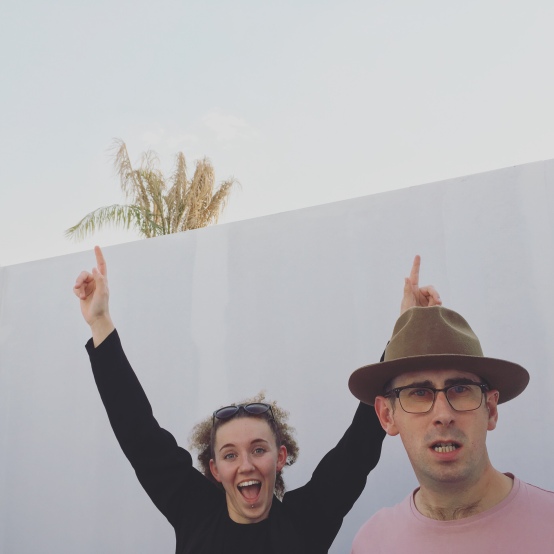
We were committed to three shows a day, each lasting 30 minutes, though in reality we walked so far to get back again that it often became more like 45. The last show each night was a parade down the main road, and we followed numerous groups of Saudi men in matching robes and headdresses who played traditional drums and sang and danced with everything from daggers to horses. The road was seemingly barricaded and closed off at either end of a two-kilometre stretch, yet every so often we would be closely followed by a bus, chased by a truck, narrowly avoided by a golf buggy, or dodged by a man on a bicycle. On the lefthand side of the road was a cheering crowd – mostly families with young children and groups of giggling teenagers eagerly waving their country’s green flags over the barrier. It’s common at these sorts of events to have separate areas for families and single men, and so when we played further in amongst the crowds we were surrounded by a more rowdy audience of energetic young males, up for a party and nothing less.
On the other side of the road it looked like the edge of the Earth. Behind more metal barriers were high mounds of uneven, dusty earth, like the dry surface of the moon; on them stood a scattering of police pickup trucks, military men with assault rifles and excitable young men in flowing white thobes and red and white ghutras (headdresses). I imagined that the people were lining up at the country’s border after wandering in the desert, craning their necks to see what was on the other side.
On the final parade night we were returned to our dressing cubicles on a golf buggy – it would have been cool, but sadly the weight of the drums and the drummers underneath them meant the buggies couldn’t move faster than about five miles per hour. Walking would have been physically harder, but less crippling on the ego. I took the opportunity to wave at every child and adult who waved a flag or a hand in our direction. My grinning face ached and my arms nearly fell off, but it was worth every cheery reaction.
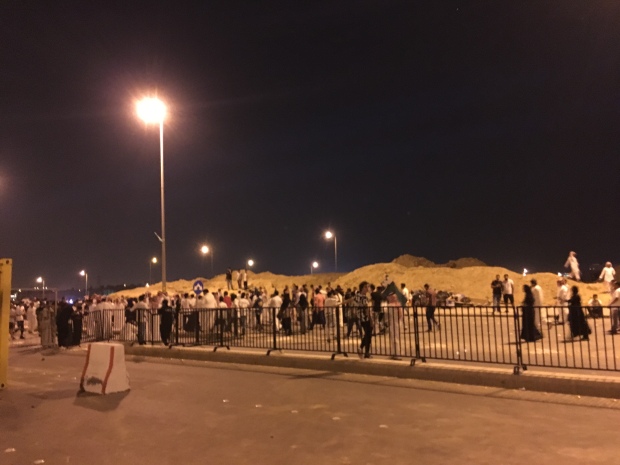
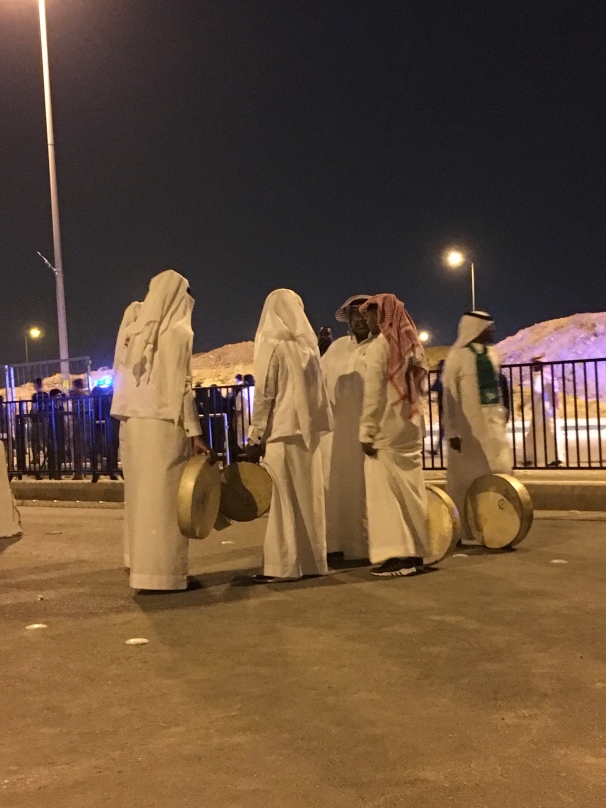
On the Sunday the centre of the hotel lobby was cordoned off with large wooden screens. We climbed upstairs to the mezzanine floor to get a look at two men constructing the world’s largest cake. They added layer upon layer of big flat cakes to an even bigger mound of… well, cake, dowsing on huge amounts of icing between each layer like bricklayers to a wall: ultimately creating one ridiculously large cake.
‘It’s the biggest cake in Saudi Arabia,’ said the man standing next to me as we leant over the bannister in astonishment, ‘400kg.’
I had no doubt this was the biggest cake in Saudi. I was convinced it was probably the biggest cake in the world, with little competition from elsewhere. We returned to the hotel later that night to find a half-demolished monster sponge covered in green icing, for Saudi National Day. Two men were handing out generous breeze-block-sized portions to everyone who entered the building, frantically trying to offload the cake, making the whole process worthwhile. It had taken four days to produce. It would surely take at least as long to consume. It was tasty and creamy, with a hint of cardamon; it was also 1AM, and we wanted nothing more than to sleep and no longer be stuffing our faces with sponge at the will of smiling hotel staff.

After seemingly ending up with more cake than we started with, we decided it was time to sleep, but were stopped on our way upstairs and redirected to the hotel restaurant, where a huge National Day feast had been laid out for the hotel guests. Not only was there an entire buffet that had apparently been prepared especially for this moment (that’s right, post-1AM on a Monday morning) – almost every dish was bright green. This was nicely colour-coordinated with the green lights on every building in Riyadh that night, as well as an abundance of flags in the lobby, and presumably every other lobby. It’s fortunate in this respect that green is the national colour, as a yellow buffet might’ve been a bit bland, and purple or black much too obscure. The salads were succulent, the pistachio baklava blissful, and whatever that delicious green mousse stuff was… well, it is no more. We were eating a full meal at two o’clock in the morning, and yet in the restaurant around us there were families with young children all wide awake and tucking into their starters: it could have been lunch time.
Other food highlights throughout the trip include the usual lashings of hummus, baba ghanoush, fattoush, tabbouleh, fragrant Arabic coffee (really more like a thick cardamon tea), and bowlfuls of Om Ali – a traditional Egyptian dessert that literally means ‘Ali’s Mother’, and is similar to bread and butter pudding, with almonds, coconut and various spices. I first discovered this dessert in Doha this year, and fear from here there is no looking back.
I have a strong belief that no city visit is complete without seeing it from the top of a very tall building: like an overview effect, it’s a chance to gain some perspective about where you are in relation to the broader area; to map out where everything is, and get a sense of the scale of a place. Our hotel happened to be just around the corner from the Kingdom Centre Tower – a 99-storey building which houses a shopping mall and Four Seasons hotel at the bottom and a skybridge at the very top. From up here, new levels of desert dust were discovered, reaching far out into the dunes and beyond.



Our few days in Riyadh got us relatively used to the concept of gender segregation – not only with the ‘men only’ sections at events, but also in the malls, where there were entirely separate shops for men’s wear and those for women and children, and public toilets, for which the ladies and gents were usually on entirely separate floors instead of being next door to one another. Saudi restaurants typically only allow families to dine together, and otherwise expect men and women to eat separately, and beaches around the country are generally split into ‘families’ and ‘single men’ areas. It was no surprise, then, upon leaving Riyadh, to discover that the airport security was split into male and female sections. We looked at the sign reading ‘Women this way’ and groaned, concerned we could be stopped and unable to turn to the rest of the team for guidance. But behind the thick, grey, ominous curtain we discovered a smiling, giggling team of women, one of whom politely asked to scan our bags and proceeded to hand them straight back with a friendly grin and a ‘Have a great trip!’. To the side sat three other women in burqas, who happily chatted away and smiled as we passed. It was an oasis of calm, the most pleasant security check of all time. Here were women who were feeling relaxed and who, without the presence of men, appeared to be creating the most supportive and welcoming atmosphere imaginable. We stepped through the curtain at the other end of the women’s area to see our male colleagues acting with the usual stony-faced seriousness required for regular security checks, collecting their bags from stern and silent guards. We were smiling and laughing. They didn’t know why.
One of the greatest benefits of working abroad is that you often find yourself in parts of the world you’d likely never have visited of your own accord, and consequently learn a great deal more about cultural norms and differences in places across the globe. There are challenges, and even conflicting moments of ‘Should I really go there?’ but ultimately every trip results in valuable experiences and knowledge that may never have been gained if the answer had simply been ‘no’. In addition, everywhere we have ever been, we’ve been accepted with the kindness of good people and their desire to show off their country in the best light. Fortunately for us, we only turn up for the parties.

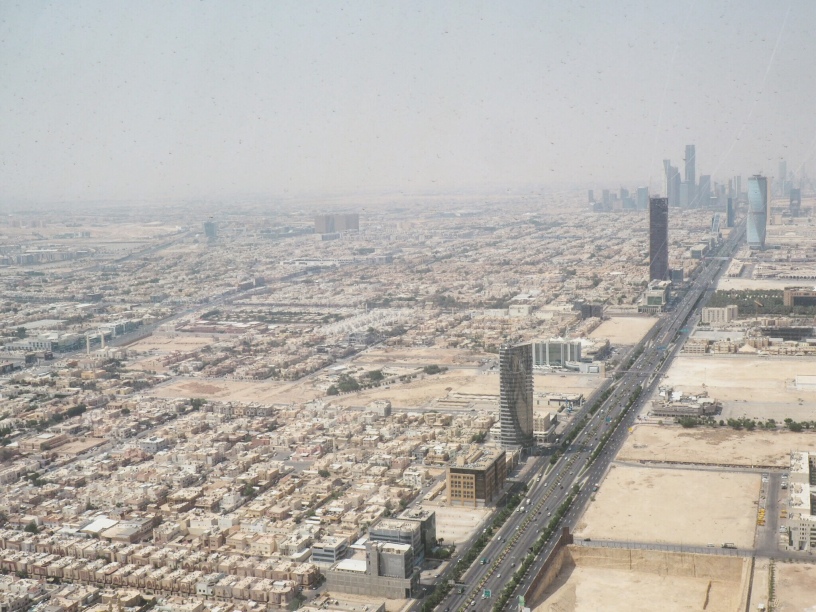




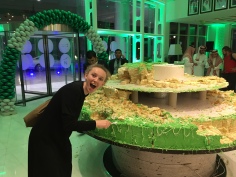

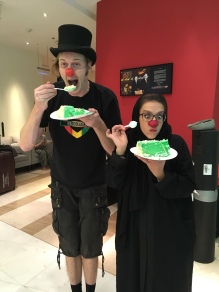

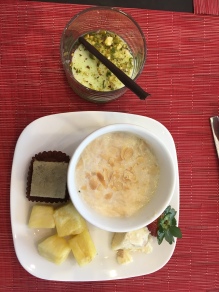




Hey Fran, I’ve loved catching up with your blog. Especially liked the fascinating and balanced perspective of this one. And that cake!
LikeLiked by 1 person
Thanks Chris. That was definitely an interesting one to write about!
LikeLike